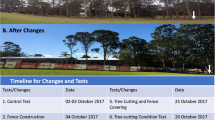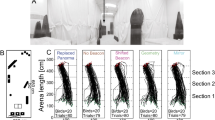Abstract
Many insects are known to use the terrestrial visual panorama for navigation. Research suggests that large-scale panoramic properties are often used for orientation rather than individual objects, usually called landmarks. We degraded the natural panorama encountered by Australian red honey ants, Melophorus bagoti, to test how robust their orientation based on the terrestrial panorama is. Foraging ants were lured to a feeder at a constant location. Trained ants were allowed to run home individually with food, but were captured just before they entered their nest. The tested ant was brought back to the location of the feeder, now covered, and allowed to run home again under different distortions of the natural panorama. In one experiment, a large tract of the view on one side of the feeder was obstructed by a tall plastic sheet. In a second experiment, the visual heights of terrestrial objects were altered by raising or lowering the ant by 80 cm. Under both kinds of distortions, the ants continued to be well oriented in the homeward direction. Navigation based on the natural terrestrial panorama proved robust to large distortions.







Similar content being viewed by others
References
Baddeley B., Graham P., Husbands P. and Philippides A. 2012. A model of ant route navigation driven by scene familiarity. PLoS Comp. Biol. 8: e1002336
Batschelet E. 1981. Circular Statistics in Biology. Academic Press, New York, London
Cheng K. 2012. Arthropod navigation: Ants, bees, crabs, spiders finding their way. In: The Oxford Handbook of Comparative Cognition (Zentall T.R. and Wasserman E.A., Eds). Oxford University Press, Oxford, New York, pp 347–365
Cheng K., Narendra A., Sommer S. and Wehner R. 2009. Traveling in clutter: Navigation in the Central Australian desert ant Melophorus bagoti. Behav. Proc. 80: 261–268
Cheng K., Shettleworth S.J., Huttenlocher J. and Rieser J.J. 2007. Bayesian integration of spatial information. Psychol. Bull. 133: 625–637
Cheng K., Schultheiss P., Schwarz S., Wystrach A. and Wehner R. 2014. Beginnings of a synthetic approach to desert ant navigation. Behav. Proc. 102: 51–61
Cheng K. and Spetch M.L. 1998. Mechanisms of landmark use in mammals and birds. In: Spatial Representation in Animals (Healy S., Ed). Oxford University Press, Oxford, New York, pp 1–17
Christian K.A. and Morton S.R. 1992. Extreme thermophilia in a Central Australian ant, Melophorus bagoti. Physiol. Zool. 65: 885–905
Collett M. 2012. How navigational guidance systems are combined in a desert ant. Curr. Biol. 22: 927–932
Collett M., Collett T.S., Bisch S. and Wehner R. 1998. Local and global vectors in desert ant navigation. Nature 394: 269–272
Cruse H. and Wehner R. 2011. No need for a cognitive map: Decentralized memory for insect navigation. PLoS Comp. Biol. 7: e1002009
Dyer F.C. 1987. Memory and sun compensation by honey bees. J. Comp. Physiol. A 160: 621–633
Etienne A.S. and Jeffery K.J. 2004. Path Integration in mammals. Hippocampus 14: 180–192
Graham P. and Cheng K. 2009a. Ants use the panoramic skyline as a visual cue during navigation. Curr. Biol. 19: R935–R937
Graham P. and Cheng K. 2009b. Which portion of the natural panorama is used for view based navigation in the Australian desert ant? J. Comp. Physiol. A 195: 681–689
Graham P. and Collett T.S. 2002. View-based navigation in insects: how wood ants (Formica rufa L.) look at and are guided by extended landmarks. J. Exp. Biol. 205: 2499–2509
Hubel D.H. and Wiesel T.N. 1959. Receptive fields of single neurones in the cat’s striate cortex. J. Physiol. 148: 574–591
Julle-Daniere E., Schultheiss P., Wystrach A., Schwarz S., Nooten S.S., Bibost A.-L. and Cheng K. 2014. Visual matching in the orientation of desert ants (Melophorus bagoti): The effect of changing skyline height. Ethol. 120: 783–792
Kohler M. and Wehner R. 2005. Idiosyncratic route memories in desert ants, Melophorus bagoti: How do they interact with path integration vectors? Neurobiol. Learn. Mem. 83: 1–12
Körding K.P., Beierholm U., Ma W.J., Quartz S., Tenenbaum J.B. and Shams L. 2007. Causal inference in multisensory perception. PLoS One 2: e943
Legge E.L.G., Spetch M.L. and Cheng K. 2010. Not using the obvious: desert ants, Melophorus bagoti, learn local vectors but not beacons in an arena. Anim. Cogn. 13: 849–860
Lehrer M., Srinivasan M.V. and Zhang S.W. 1990. Visual edge detection in the honeybee and its chromatic properties. Proc. R. Soc. B-Biol. Sci. 238: 321–330
Lent D., Graham P. and Collett T.S. 2013. Visual scene perception in navigating wood ants. Curr. Biol. 23: 684–690
Möller R. 2002. Insects could exploit UV-green contrast for landmark navigation. J. Theor. Biol. 214: 619–631
Möller R. 2012. A model of ant navigation based on visual prediction. J. Theor. Biol. 305: 118–130
Muser B., Sommer S., Wolf H. and Wehner R. 2005. Foraging ecology of the thermophilic Australian desert ant, Melophorus bagoti. Aust. J. Zool. 53: 301–311
Pratt S.C., Brooks S.E. and Franks N.R. 2001. The use of edges in visual navigation by the ant Leptothorax albipennis. Ethol. 107: 1125–1136
Reid S.F., Narendra A., Hemmi J.M. and Zeil J. 2011. Polarised skylight and the landmark panorama provide night-active bull ants with compass information during route following. J. Exp. Biol. 214: 363–370
Schultheiss P. and Nooten S.S. 2013. Foraging patterns and strategies in an Australian desert ant. Austral Ecol. 38: 942–951
Schwarz S., Narendra A. and Zeil J. 2011. The properties of the visual system in the Australian desert ant Melophorus bagoti. Arthropod Struct. Dev. 40: 128–134
Seelig J.D. and Jayaraman V. 2013. Feature detection and orientation tuning in the Drosophila central complex. Nature 503: 262–266
Sommer S., von Beeren C. and Wehner R. 2008. Multiroute memories in desert ants. Proc. Natl Acad. Sci. USA 105: 317–322
Towne W.F. 2008. Honeybees can learn the relationship between the solar ephemeris and a newly-experienced landscape. J. Exp. Biol. 211: 3737–3743
Towne W.F. and Moscrip H. 2008. The connection between landscapes and the solar ephemeris in honeybees. J. Exp. Biol. 211: 3729–3736
von Frisch K. and Lindauer M. 1954. Himmel und Erde in Konkurrenz bei der Orientierung der Bienen [Sky and Earth in competition in the orientation of bees]. Naturwissenschaften 41: 245–253
Wehner R. 1994. The polarization-vision project: championing organismic biology. Fortschritte Zool. 39: 103–143
Wehner R. 1997. The ant’s celestial compass system: spectral and polarization channels. In: Orientation and Communication in Arthropods (Lehrer M., Ed), Birkhäuser Verlag, Basel. pp 145–185
Wehner R., Boyer M., Loertscher F., Sommer S. and Menzi U. 2006. Ant navigation: One-way routes rather than maps. Curr. Biol. 16: 75–79
Wehner R., Michel B. and Antonsen P. 1996. Visual navigation in insects: coupling of egocentric and geocentric information. J. Exp. Biol. 199: 129–140
Wehner R. and Müller M. 2006. The significance of direct sunlight and polarized skylight in the ant’s celestial system of navigation. Proc. Natl Acad. Sci. USA 103: 12575–12579
Wehner R. and Srinivasan M.V. 2003. Path integration in insects. In: The Neurobiology of Spatial Behaviour (Jeffery K.J., Ed), Oxford University Press, Oxford. pp 9–30
Wiener J., Shettleworth S., Bingman V.P., Cheng K., Healy S., Jacobs L.F., Jeffery K.J., Mallot H.A., Menzel R. and Newcombe N.S. 2011. Animal navigation: A synthesis. In: Animal Thinking: Contemporary Issues in Comparative Cognition (Menzel R. and Fischer J., Eds), MIT Press, Cambridge, MA, London. pp 51–76
Wystrach A., Beugnon G. and Cheng K. 2011a. Landmarks or panoramas: what do navigating ants attend to for guidance? Front. Zool. 8: 21
Wystrach A., Cheng K., Sosa S. and Beugnon G. 2011b. Geometry, features, and panoramic views: Ants in rectangular arenas. J. Exp. Psychol.: Anim. Behav. Proc. 37: 420–435
Wystrach A., Schwarz S., Schultheiss P., Beugnon G. and Cheng K. 2011c. Views, landmarks, and routes: how do desert ants negotiate an obstacle course? J. Comp. Physiol. A 197: 167–179
Wystrach A., Beugnon G. and Cheng K. 2012. Ants might use different view-matching strategies on and off the route. J. Exp. Biol. 215: 44–55
Wystrach A., Mangan M., Philippides A. and Graham P. 2013a. Snapshots in ants? New interpretations of paradigmatic experiments. J. Exp. Biol. 216: 1766–1770
Wystrach A., Schwarz S., Baniel A. and Cheng K. 2013b. Backtracking behaviour in lost ants: an additional strategy in their navigational toolkit. Proc. R. Soc. B-Biol. Sci. 280: 20131677
Wystrach A., Philippides A., Aurejac A., Cheng K. and Graham P. 2014a. Visual scanning behaviours and their role in the navigation of the Australian desert ant Melophorus bagoti. J. Comp. Physiol. A 200: 615–626
Wystrach A., Schwarz S., Schultheiss P., Baniel A. and Cheng K. 2014b. Multiple sources of celestial compass information in the Central Australian desert ant Melophorus bagoti. J. Comp. Physiol. A 200: 591–601
Zeil J., Hofmann M.I. and Chahl J.S. 2003. Catchment areas of panoramic snapshots in outdoor scenes. J. Optic. Soc. Am. 20: 450–469
Zeil J., Narendra A. and Stürzl W. 2014. Looking and homing: how displaced ants decide where to go. Phil. Trans. R. Soc. B 369: 20130034
Zhou Y., Ji X., Gong H., Gong Z. and Liu L. 2012. Edge detection depends on achromatic channel in Drosophila melanogaster. J. Exp. Biol. 215: 3478–3487
Acknowledgments
We would like to thank the Centre for Appropriate Technology, Alice Springs, for letting us do field research on their site, and supplying storage space, and the CSIRO Sustainable Ecosystems at Alice Springs for providing some administrative help. Thanks to Simon Griffith for help with photospectrometry. Funding was provided by the Australian Research Council in a Discovery Project Grant (DP110100608).
Conflict of interest
The authors declare no conflict of interest.
Author information
Authors and Affiliations
Corresponding author
Rights and permissions
About this article
Cite this article
Schwarz, S., Julle-Daniere, E., Morin, L. et al. Desert ants (Melophorus bagoti) navigating with robustness to distortions of the natural panorama. Insect. Soc. 61, 371–383 (2014). https://doi.org/10.1007/s00040-014-0364-4
Received:
Revised:
Accepted:
Published:
Issue Date:
DOI: https://doi.org/10.1007/s00040-014-0364-4




